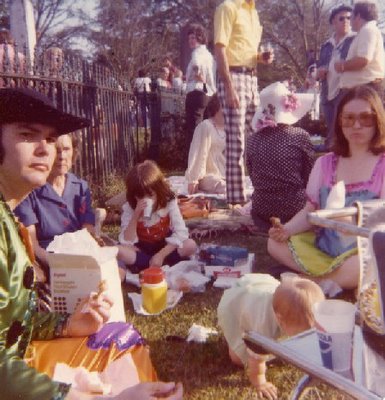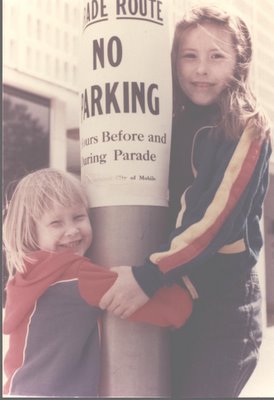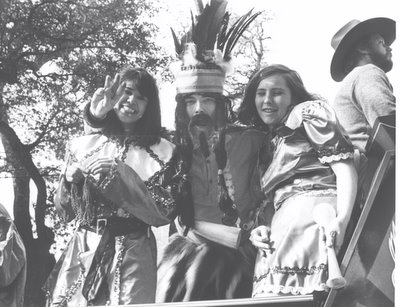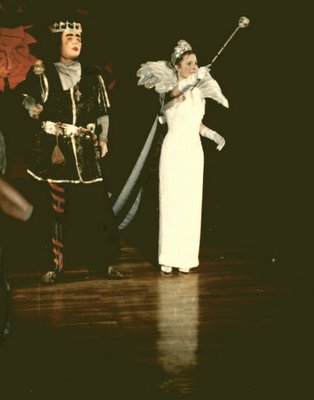The 2006 Rex Procession: “Beaux Arts and Letters”
Tuesday, February 28, 2005
New Orleans, Louisiana
1. Rex, King of Carnival, Monarch of Merriment Rex’s float carries the King of
Carnival and his pages through the streets of New Orleans on Mardi Gras day.
2. His Majesty’s Bandwagon A band rides on this permanent float to provide
music for Rex and for those who greet him on the parade route.
3. The King’s Jesters Even the Monarch of Merriment needs jesters in his court.
Rex’s jesters dress in Mardi Gras colors—purple, green, and gold.
4. The Boeuf Gras This is one of the oldest symbols of Mardi Gras, symbolizing
the great feast on the day before Lent begins.
5. Title Float: “Beaux Arts and Letters” While Rex Processions of past years
have presented the history and culture of far-flung civilizations, this year’s theme
explores the joys and beauties of Rex’s own empire and domain. New Orleans
has a long and rich artistic history and has produced a wealth of artists and
writers of national and international renown. Sculptors and painters, writers and
poets have called New Orleans home, and have found inspiration for their work
in her history, culture, and landscapes. Mardi Gras, the celebration unique to
this city, has influenced the work of many of our artists and writers.
6. John James Audubon (1785-1851) Audubon, the pre-eminent American
painter of birds and wildlife, was born in Haiti and came to America at age
eighteen, living in Pennsylvania and Kentucky before traveling south with little
more than his gun and his painting equipment. He arrived in New Orleans in
1821, living for a time at 701 Barracks St. where he painted and taught drawing.
He worked for several years in the Felicianas, especially at Oakley plantation. He
is best known for his great work, “Birds of America.”
7. Robert Tallant “Voodoo” (1909-1957) Born and educated in New Orleans,
Robert Tallant is best known for a series of books and articles describing the
history and culture of New Orleans. As an editor working with the Louisiana
Writers’ Project for the WPA he helped write “Gumbo Ya-Ya,” which described
the rich folklore of New Orleans. “Voodoo” was one of his later books, a detailed
(if somewhat sensational) exploration of this interesting part of New Orleans
culture. He also taught English at Newcomb College and wrote for the New
Orleans Item.
8. George Ohr (1857-1918) Sometimes called “the mad potter of Biloxi,” George
Edgar Ohr learned many of his potting skills in New Orleans before returning to
Biloxi to create the unique pots he called his “mud babies.” He claimed the
motto “no two alike,” and his style of pinched and twisted forms produced art
pottery which was not really valued during his lifetime. Thousands of his pots
were left in boxes to be discovered many years after his death. This unique artist
and his work are honored in the recently founded George Ohr Museum in Biloxi,
Mississippi.
9. Perry Young “The Mistick Krewe” This float honors the Mistick Krewe of
Comus on its 150th anniversary, with float elements depicting the Comus cup and
the celebrations of the “Cowbellians,” from which the Mistick Krewe took
inspiration. Perry Young is best known for his 1931 history of Carnival in New
Orleans, “The Mistick Krewe: Chronicles of Comus and His Kin.” In his preface
Young describes Carnival as “a butterfly of winter, whose last mad flight of
Mardi Gras forever ends his glory.”
10. John Kennedy Toole “Confederacy of Dunces” (1937-1969) In his bestknown
work, Toole created a most colorful New Orleans character, Ignatius P.
Reilly. Toole’s description of Reilly begins: “A green hunting cap squeezed the
top of the fleshy balloon of a head….” Toole earned degrees from Tulane and
Columbia Universities and taught English at Dominican College. “A
Confederacy of Dunces” was published after his death through the persistence of
his mother, Thelma Toole, and with the help of Walker Percy. It won the Pulitzer
Prize for fiction in 1980.
11. Louis Andrews Fischer “Living Jewels” (1901-1974) Louis Fischer was given
her father’s name when she was born in Mobile in 1901. An imaginative child
who loved poetry and fanciful fiction (“Alice in Wonderland” was a favorite) she
studied art at Newcomb College. In her Pontalba apartment she designed many
beautiful Carnival parades, including the Rex parades from the 1920’s through
the early 1930’s. One of her most beautiful Rex parades was that of 1930, titled
“The Jewels of Rex,” which inspired this float.
12. Grace King “New Orleans, the Place and the People” (1852-1932) Grace
King was a life-long New Orleanian whose fiction and non-fiction writing helped
the nation and the world better understand post-Civil War New Orleans and the
South. She was well known and respected in national literary circles, and was
proud to call herself, in the title of her autobiography, “A Southern Woman of
Letters.” “New Orleans, the Place and the People,” published in 1895, is her bestknown
non-fiction work, an affectionate and beautifully illustrated history of our
city.
13. Caroline Durieux “Mardi Gras Day” (1896-1989) Caroline Spellman Wogan
Durieux studied art with Ellsworth Woodward at Newcomb College, and later at
the Philadelphia Academy of Fine Arts. Prior to teaching art at LSU she was the
director of the Federal Art Project in Louisiana. She is best known for her
humorous and satiric lithographs, many drawing on the characters and culture
of New Orleans. “Mardi Gras Day” is a 1948 compilation of sketches and
drawings by Durieux, Ralph Wickiser, and John McCrady depicting images from
a “typical” Mardi Gras day.
14. The Streetcar Named Desire This permanent float honors the most famous
of all of New Orleans’ streetcar lines.
His Majesty’s Royal Calliope The Rex procession presents a musical interlude
provided by His Majesty’s traditional calliope.
15. Lyle Saxon “Father Mississippi” (1891-1946) Lyle Saxon began his writing
career as a reporter for several New Orleans papers, ending his newspaper career
as one of the Times-Picayune’s most renowned journalists. In 1926 he went to
New York City to write novels, one of which, “Father Mississippi” (1927)
inspired this float. During the WPA years he was Director of the Louisiana
Writer’s Project. A resident of the French Quarter, where his literary circle
included William Faulkner, Saxon also did some of his writing in a cabin at
Melrose Plantation.
16. Enrique Alferez (1901-1999) Enrique Alferez was born in northern Mexico
and divided his time between New Orleans and the land of his birth. A prolific
artist and sculptor, many of his works grace New Orleans’ favorite public spaces,
including the New Orleans Botanical Garden and City Park, and can be found in
many distant cities as well. Mr. Alferez was an energetic and enthusiastic man,
and is remembered as one of New Orleans’ most unique characters. The human
figure inspired many of his drawings and sculptures.
17. Ida Kohlmeyer (1912-1997) Ida Kohlmeyer did not take up painting until she
was in her thirties, but she developed a unique style which made her one of New
Orleans’ favorite and most renowned artists and sculptors. Her first degree from
Newcomb College was in English Literature, but she returned to its art school for
her Master’s Degree. Her work is found in major national museum collections
and graces many homes and public spaces in New Orleans, where she painted
and sculpted nearly every day until her death. New Orleans’ own Ogden
Museum of Southern Art is home to the Ida Kohlmeyer Study Center, which
preserves an extensive Kohlmeyer archive.
18. Bror Anders Wikstrom “Rex 1885-1910” (1854-1909) While Wikstrom is
honored here for his elegant designs for some of the most beautiful of all Rex
parades, he was also a versatile and accomplished painter. Born in Sweden, he
ran away to sea at the age of fourteen, but returned to study painting at the
Swedish Royal Academy. During his 25 years in New Orleans he helped found
the Artists’ Association of New Orleans, taught art and drawing, and was part of
a distinguished circle of artists which included the Woodward brothers.
19.Walker Percy “The Moviegoer” (1916-1990) Walker Percy trained to be a
physician, but contracted tuberculosis when he was twenty-six. Following his
extended confinement, he began to write, exploring the human condition in a
series of novels and non-fiction works. His literary characters were often
engaged in a search for greater meaning in their lives. This was certainly true of
Binx Bolling, an alienated stockbroker, and the moviegoer of this float’s title. Dr.
Percy lived and worked in Covington, Louisiana.
20. William Faulkner “Mosquitoes” (1897-1962) William Faulkner grew up in
Oxford, Mississippi, and lived and worked for many years in New Orleans.
“Mosquitoes” was his second novel, and is not widely read. It takes place on a
yacht in Lake Ponchartrain, and is loosely based on the characters in his literary
circle during his New Orleans years. He won the Nobel Prize for literature in
1949, cited for “his powerful and artistically unique contribution to the American
novel.”
21. Newcomb Pottery Josephine Newcomb’s gift in 1886 encouraged a broad
vision of education “both practical and literary.” This surely was true in the Art
Department, where Ellsworth Woodward and others encouraged the study of art
both as a program of vocational training for young women and the creation of
fine works of art. The Newcomb Pottery, established by Woodward and Mary
Given Sheerer in 1894, exemplified this blend of beauty and function. Newcomb
Pottery became famous for graceful forms, exquisite glazes, and designs drawn
from Louisiana flora. The pottery closed in 1940.
22. Clementine Hunter (1886-1988) Clementine Hunter, one of the south’s most
famous and beloved self-taught artists, was born on a cotton plantation near
Cloutierville, LA. When she was a teenager she moved to the Melrose Plantation
in Cane River country. Melrose was a haven for artists and writers, and Mrs.
Hunter’s creativity with quilts and dolls was noticed and encouraged. She began
to make paintings with leftover materials or paints given to her by the “real”
artists. Her first painting was on a linen window shade. Over her long life she
created more than 4000 “memory paintings,” each telling a story in her clear and
straightforward way.
23. Tennessee Williams “The Glass Menagerie”(1911-1983) Born Thomas Lanier
Williams, III in Columbus, Mississippi, Tennessee Williams was one of America’s
greatest playwrights. He moved to New Orleans in 1939, and wrote “A Streetcar
Named Desire” while living on St. Peter Street. While he lived in New York and
other cities, he always called New Orleans his “spiritual home,” and New
Orleans celebrates his work with the annual Tennessee Williams Festival.
Williams grew up in a conflicted and dysfunctional family, and many of the
characters in his plays mirror the troubled and tumultuous world he knew well.
That is certainly true of the characters in “The Glass Menagerie.
24. Lafcadio Hearn “The Night of All Saints” (1850-1904) Born in Greece,
Lafcadio Hearn was a prolific and colorful writer in New Orleans in the 1880’s.
He wrote for several of the city’s papers, and his descriptions of New Orleans, its
culture and characters, endures for its vividness and wit. In 1889 he went to
Japan, learned Japanese, married a Japanese woman, and became a professor at
the Imperial University. While he is known around the world for his writings
about Japan, his New Orleans period is not as widely studied. “The Night of All
Saints” is one of Hearn’s sketches compiled after his death by Charles Hutson,
and published in 1919 as “Fantastics and other Fancies.”
25. Walter Inglis Anderson (1903-1965) Anderson was born and spent his early
years in New Orleans. He graduated from the Pennsylvania Academy of Fine
Arts, and studied abroad before returning to live and work in Ocean Springs.
During the WPA years he painted murals in public buildings, many of which
survive. He struggled with mental illness throughout his adult life, and lead an
increasingly isolated life. He spent many years going back and forth to Horn
Island, studying the natural world around him and trying to capture it in his
intense and lyric style. These years produced much of the art by which we
remember this remarkable artist.
26. Kate Chopin “Bayou Folk” (1851-1904) Kate O’Flaherty Chopin spent most
of her life in her native St. Louis, but her literary legacy drew on the fourteen
years she lived in Louisiana. At age nineteen she married Oscar Chopin, a cotton
broker, and they lived in New Orleans and Cloutierville, Red River country. She
returned to St. Louis in 1882, a widow with six children, and when she began to
write it was about the Acadians and Creoles with whom she had lived. “Bayou
Folk” was published in 1894, and describes, with colorful use of dialect, the
people and customs of Acadiana.
27. The Royal Barge The Royal Barge is a permanent float, complete with Royal
Gryphon, and brings the Rex Procession of 2005 to a close.








